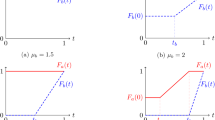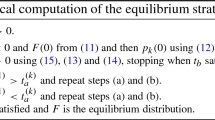Abstract
We study a class of single-server queueing systems with a finite population size, FIFO queue discipline, and no balking or reneging. In contrast to the predominant assumptions of queueing theory of exogenously determined arrivals and steady state behavior, we investigate queueing systems with endogenously determined arrival times and focus on transient rather than steady state behavior. When arrival times are endogenous, the resulting interactive decision process is modeled as a non-cooperative n-person game with complete information. Assuming discrete strategy spaces, the mixed-strategy equilibrium solution for groups of n = 20 agents is computed using a Markov chain method. Using a 2 × 2 between-subject design (private vs. public information by short vs. long service time), arrival and staying out decisions are presented and compared to the equilibrium predictions. The results indicate that players generate replicable patterns of behavior that are accounted for remarkably well on the aggregate, but not individual, level by the mixed-strategy equilibrium solution unless congestion is unavoidable and information about group behavior is not provided.
Similar content being viewed by others
References
Bearden, J.N., Rapoport, A., and Seale, D.A. (in press). “Entry Times in Queues with Endogenous Arrivals: Dynamics of Play on The Individual and Aggregate Levels. In R. Zwick and A. Rapoport (eds.), Experimental Business Research II. Norwell, MA: Kluwer Academic Publishers.
Glazer, A. and Hassin, R. (1983). “?/M/1: On the Equilibrium Distribution of Customer Arrivals.” European Journal of Operational Research 13, 146–150.
Hall, R.W. (1991). Queueing Methods Upper Saddle River, NJ: Prentice-Hall.
Hassin, R. and Haviv, M. (2003). To Queue or not to Queue: Equilibrium Behavior in Queueing Systems Boston: Kluwer.
Hillier, F.S. and Lieberman, G.J. (2001). Introduction to Operations Research 7th edition Boston: McGraw-Hill.
Holt, C.A. Jr. and Sherman, R. (1982). “Waiting-Line Auctions.” Journal of Political Economy. 90, 280–294.
Medhi, J. (1991). Stochastic Models in Queueing Theory. Boston: Academic Press.
Naor, P. (1969). “The Regulation of Queue Size by Levying Tolls.” Econometrica 37, 15–23.
Rapoport, A., Stein, W.E., Parco, J.E., and Seale, D.A. (2004). “Strategic Play in Single-Server Queues with Endogenously Determined Arrival Times.” Journal of Economic Behavior and Organization 55, 67–91.
Author information
Authors and Affiliations
Corresponding author
Additional information
JEL Classification: C71, C92, D81
Rights and permissions
About this article
Cite this article
Seale, D.A., Parco, J.E., Stein, W.E. et al. Joining a Queue or Staying Out: Effects of Information Structure and Service Time on Arrival and Staying Out Decisions. Exp Econ 8, 117–144 (2005). https://doi.org/10.1007/s10683-005-0872-1
Received:
Revised:
Accepted:
Issue Date:
DOI: https://doi.org/10.1007/s10683-005-0872-1




